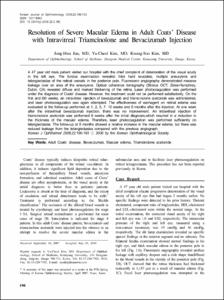Resolution of Severe Macular Edema in Adult Coats’ Disease with Intravitreal Triamcinolone and Bevacizumab Injection
- Keimyung Author(s)
- Jun, Jong Hwa; Kim, Yu Cheol; Kim, Kwang Soo
- Department
- Dept. of Ophthalmology (안과학)
- Journal Title
- Korean Journal of Ophthalmology
- Issued Date
- 2008
- Volume
- 22
- Issue
- 3
- Abstract
- A 47 year old male patient visited our hospital with the chief complaint of deterioration of the visual acuity in the left eye. The fundus examination revealed thick hard exudates, multiple aneurysms and telangiectasias of the retinal vessels in the posterior pole. Fluorescein angiography demonstrated massive leakage over an area of the aneurysms. Optical coherence tomography (Stratus OCT; Zeiss-Humphrey,
Dubin, CA) revealed diffuse and marked thickening of the retina. Laser photocoagulation was performed under the diagnosis of Coats’ disease. However, the treatment could not be performed satisfactorily. On the first and 6th weeks, an intravitreal injection of bevacizumab and triamcinolone acetonide was administered, and laser photocoagulation was again attempted. The effectiveness of eachagent on retinal edema was evaluated at the follow-up performed at 1, 2, 5, 7, 10 weeks and 6 months after the injection. At one week after the intravitreal bevacizumab injection, there was no improvement. An intravitreal injection of triamcinolone acetonide was performed 6 weeks after the initial diagnosis,which resulted in a reduction in the thickness of the macular edema. Therefore, laser photocoagulation was performed sufficiently on
telangiectasias. The follow-up at 6 months showed a relative increase in the macular edema, but there was reduced leakage from the telangiectasias compared with the previous angiograph.
- Publisher
- School of Medicine
- Citation
- Jong-Hwa Jun et al. (2008). Resolution of Severe Macular Edema in Adult Coats’ Disease with Intravitreal Triamcinolone and Bevacizumab Injection. Korean Journal of Ophthalmology, 22(3), 190–193. doi: 10.3341/kjo.2008.22.3.190
- Type
- Article
- ISSN
- 1011-8942
- Appears in Collections:
- 1. School of Medicine (의과대학) > Dept. of Ophthalmology (안과학)
- 파일 목록
-
-
Download
 oak-aaa-03470.pdf
기타 데이터 / 3.43 MB / Adobe PDF
oak-aaa-03470.pdf
기타 데이터 / 3.43 MB / Adobe PDF
-
Items in Repository are protected by copyright, with all rights reserved, unless otherwise indicated.